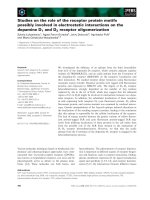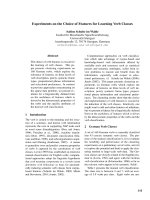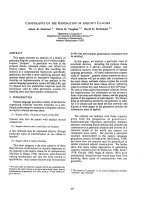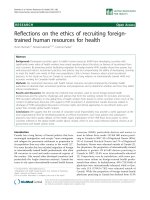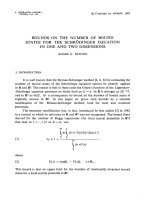Báo cáo y học: "Update on the treatment of ocular toxoplasmosis"
Bạn đang xem bản rút gọn của tài liệu. Xem và tải ngay bản đầy đủ của tài liệu tại đây (807.39 KB, 3 trang )
Int. J. Med. Sci. 2009, 6
140
I
I
n
n
t
t
e
e
r
r
n
n
a
a
t
t
i
i
o
o
n
n
a
a
l
l
J
J
o
o
u
u
r
r
n
n
a
a
l
l
o
o
f
f
M
M
e
e
d
d
i
i
c
c
a
a
l
l
S
S
c
c
i
i
e
e
n
n
c
c
e
e
s
s
2009; 6(3):140-142
© Ivyspring International Publisher. All rights reserved
Short Communication
Update on the treatment of ocular toxoplasmosis
Yan Guex-Crosier
Hôpital Ophtalmique Jules Gonin, Lausanne (Switzerland)
Published: 2009.03.19
Ocular toxoplasmosis is the most frequent cause
of posterior uveitis. [1] The parasite has an intracel-
lular cycle. During the primary infection, the subject is
usually asymptomatic and can present flu-like
symptoms. A dissemination of the parasites occurs
and the tissular cysts will persist during the all life of
the host. An ocular reactivation of the disease can
occur when the cysts are present within the retina
(Figure 1). The patients present a photophobia and
floaters are seen. The slit-lamp examination reveals
the presence of a granulomatous inflammation, a mild
to moderate anterior chamber inflammation. Fundo-
scopy reveals the presence of a yellow focus of reti-
nochoroiditis. Recent epidemiological data have
shown that most cases of ocular toxoplasmosis result
from reactivation of ocular toxoplasmosis and not
from primary infection. Disease evolution depends on
many factors: the immune response of the host, the
virulence of the parasite and environmental factors
and ocular toxoplasmosis can heals spontaneously
after two to three months even in the absence of
therapy.
A review of ophthalmic literature shows that no
standard therapy could be proven by large multicen-
tric clinical trials. [2] A survey of the opinion of oph-
thalmic specialists in uveitis was performed recently
by Gary Holland. [3] The reasons that were commonly
accepted to introduce a therapy were the following: a)
the presence of a lesion within the vascular arcades of
the posterior pole (zone 1) b) the presence of a lesion
in the proximity of the optic nerve or the macula c) or
a severe inflammatory reaction within the eyes. The
zone 1 area was defined as a lesion that was in a
sight-threatning area and corresponding to an area
extending 3000 μm (2 disk diameters) from the fovea
(approximately that area enclosed by the major tem-
poral vascular arcades or 1500 μm from the margins of
the optic disk.
The prospective study performed by Perkins in
1956 could not demonstrate the efficacy of daraprim
in the therapy of ocular toxoplasmosis. But the out-
come was measured 4 weeks after initiation of ther-
apy. Dihydrofolate reductase inhibitors (DHFR) have
shown their efficacy in vivo in the treatment of
toxoplamosis. To increase the efficacy of therapy a
combination of sulfadiazine and pyrimethamine was
proposed since synergistic effect of these two drugs
could be demonstrated in vitro. Pyrimethamine in-
terferes with the conversion of folic acid to folinic acid
through dihydropteroate synthase (DHPS) whereas
sulfonamide interferes with the formation of folic acid
from para-amino benzoic acid. Human beings unlike
T. gondii can utilize exogenous folinic acid for their
cells.
Classical therapy of ocular toxoplasmosis con-
sists in a association of 2 to 4.0 g of sulfadiazine
loading dose given over 24 hours, followed by 1g
given 4 times daily associated with 75mg to 100mg
pyrimethamine loading dose initially followed by 25
to 50 mg daily. Systemic steroids 1mg/kg is associ-
ated in the presence of severe ocular inflammation or
in the presence of a zone 1 infection. A prospective
randomised trial of trimethoprim/sulfamethoxazole
versus pyrimethamine and sulfadiazine described a
61% reduction of lesions size was observed in the
classic treatment group versus 59% in the TMP/S
group. Reaction to sulfadiazine therapy is observed in
overall 5% of patients. The main side effects are crys-
talluria, disorders of hematopoietic system hypersen-
sitivity reaction nausea and vomiting and depression.
The sulfadiazine cristalluria occurs in 1-4% of pa-
tients. The predisposing factors are a poor fluid in-
take, fever, diarrhoea, hypoalbuminuria and acidifi-
cation of the urine. Cofactors in AIDS patients are
concomitant use of acyclovir, triamterene or primi-
done. The leukopenia or thrombocytemia occur in the
Int. J. Med. Sci. 2009, 6
141
presence of interactions with the metabolism of folic
acid. Folinic acid therapy is given three times a week
to avoid leukopenia. Discontinuation of the therapy is
recommended if the leukocytes are below 4 000 cells
or if thrombocytes are below 100 000 cells.
Maculo-papular rush appears in the presence of an
allergy to sulfadiazine.
Atovaquone therapy is used as second line
treatment of toxoplasmosis. Atovaquone tablets
750mg QID have been given for the treatment of
Toxoplasma retinochoroiditis. Azithromycine is an
alternative to classical therapy was proposed as an
alternative therapy in the treatment of ocular
toxoplasmosis. The efficacy of the drug was reported
in cerebral toxoplasmosis in AIDS patients. The dos-
age used by Rothova et al was 250mg a day or 500mg
every other day and therapy was associated with
pyrimethamine 100mg on the first day that was fol-
lowed by 50mg a day.
Prophylaxy of recurrence of toxoplamic reti-
nochoroiditis
Long term intermittent Trimethoprim
/Sulfamethoxazole treatments were used to prevent
recurrences of toxoplasmic retinochoroiditis. Treat-
ment was given every three days with a dosage of
60mg trimethoprim and 160mg Sulfamethoxazole.
Recurrences were observed in only 6.6% versus 23.6%
in the placebo group. However the results were not
tested after 20 months of therapy and long term side
effects are not known.
Therapy of toxoplasmosis-associated ne-
ovascular lesions
Toxoplasmosis-associated neovascular lesions
are a rare complication of toxoplasmic retinochoroid-
itis. Photodynamic therapy with Visudyne was shown
to block evolution in two out of three patients affected
by neovascularization. Ranibizumab was shown to be
a good alternative of therapy in three patients. Geno-
type studies and in vitro growth rates and resistance.
Genotypic strains of toxoplasma gondii and re-
sistance to medication were recently suspected. De-
spite the fact that all clonage lineages can infect hu-
man beings, type II strains are predominant in Euro-
pean and North American population. Type III and
recombinant I/III strains are predominant are pre-
dominant in South America. Various virulence has
been demonstrated: Type I are highly virulent, type III
strains are intermediate and type I/II are non virulent.
Most of pharmacological studies were performed
with RH strains (type I) which was used for its high
capacity to grow in culture. A recent paper of Pascale
Meneceur et al has shown that no significant differ-
ence in response to type I, II or III and one atypical
strain was observed in the IC
50
of the different strains
towards pyrimethamine, sulfadiazine or atovaquone
therapy. A correlation was observed between IC
50
of
pyrimethamine and strain growth rate.
In conclusion, larges randomised clinical studies
will be necessary to prove the advantage of one drug
toward the other. These studies should be completed
by strains analyses and comparison of potential re-
sistance toward the antitoxoplasmic drugs.
Figure 1: Active retinitis area adjacent to previous cica-
tricial foci.
References
1. Holland GN, Lewis KG. An update on current practices in the
management of ocular toxoplasmosis. Am J Ophthalmol
2002;134:102-14.
2. Silveira C, Belfort RJr., Muccioli C, et al. The effect of long-term
intermittent trimethoprim/sulfamethoxazole treatment on re-
currences of toxoplasmic retinochoroiditis. Am J Ophthalmol
2002;134:41-6.
Int. J. Med. Sci. 2009, 6
142
3. Meneceur P, Bouldouyre MA, Aubert D, et al. In vitro suscep-
tibility of various genotypic strains of Toxoplasma gondii to
pyrimethamine, sulfadiazine, and atovaquone. Antimicrob
Agents Chemother 2008;52:1269-77.



